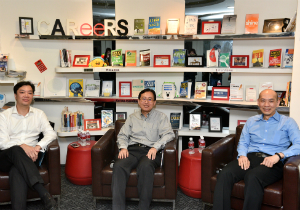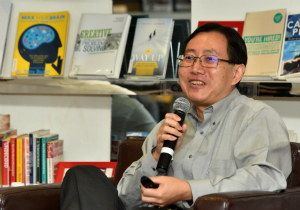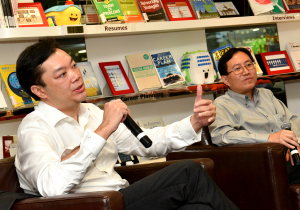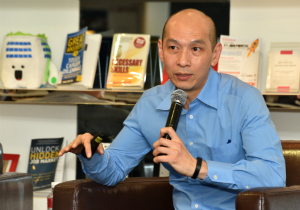Singapore Polytechnic's new Smart Campus platform seeks to transform education through smart technologies.

Discussing Smart Campus possibilities: (from left) Mr Chris Tng from NCS, Mr Loh Gin Chye from SP and Mr Marcus Lim from Cisco.
An engineering student walks into the library and is notified about a new book related to his course. He also finds out, via a mobile app, where the less crowded spaces are within the library, — just in case he needs a cozy quiet corner to study.
These scenarios are another step in Singapore Polytechnic’s (SP) journey towards a Smart Campus – which began with the introduction of computer-based learning and computer literacy in the 1980s.
Today, SP’s Smart Poly vision is to enhance teaching and learning and to improve the quality of work and life amongst the SP community through technology, said Mr Loh Gin Chye, Director, Information and Digital Technology Services, SP.
The idea is to incorporate smart technology in the campus. In line with this, there are 22 projects that SP will implement in the areas of smart teaching and learning; smart security and safety; smart energy; smart working and lifestyle; and smart capabilities.

Mr Loh Gin Chye: SP’s Smart Poly vision is to enhance teaching and learning and to improve the quality of work and life amongst the SP community through technology.
Some of these are already being rolled out under a collaboration between SP, Cisco and NCS to create a future-ready campus.
Announced on 19 January, the aim is digital transformation through the use of sensors, devices, networks and data to deliver services that will boost teaching, learning and operational efficiency.
The digitalisation of the campus will also enable the collection, analysis and evaluation of datasets to provide insights and intelligence that will help SP to fine-tune its service offerings.
Smart Education is a key pillar of the Smart Campus.
Smart Education
“When you look at Smart Cities, it is about connecting services. In the case of Smart Education, it is about connecting and delivering services to students starting from the home and giving them access to information at their fingertips,” said Mr Chris Tng, Director, Business Development, Smart & Safe City Centre of Excellence, NCS.
“Our vision is that in a Smart Campus, the student is always at the core. When we drive transformation in this space, we need to put in technology where it will support the user experience and deliver learning outcomes.”

Mr Chris Tng: When we drive transformation in this space, we need to put in technology where it will support the user experience and deliver learning outcomes.
At SP, technology is being used to support the flipped classroom, a pedagogical model where the typical sequence of a lesson followed by homework is reversed.
With this approach, the lecturer creates video-based learning packages and uploads them into the cloud, so that students can access and view them before the lesson.
Classroom time is used to poll the student’s understanding and plug learning gaps. Lecturers are able to go in-depth into the lessons and tap on learning analytics services and tools to customise their teaching plans and provide help for students.
The flipped classroom was first piloted with over 300 engineering mathematics students at the polytechnic. “94 per cent of students found it to be more engaging, and the lecturers had more time to facilitate student learning more effectively,” said Mr Loh.
A key component of the Smart Campus is unified communications, which makes it possible for students to attend e-lectures during home-based learning and lecturers to provide online consultations.
Devices with augmented reality capabilities are also being used to deliver an immersive learning experience so that students can, for example, visualise aircraft engine models and building designs in 3D during lessons.
Mr Marcus Lim, Director, Education, Asia Pacific, Cisco, said while traditionally technology has been used to address the efficiency of education, Smart Education could lead to the introduction of new models that address the effectiveness of education.

Mr Marcus Lim: Smart Education could lead to the introduction of new models that address the effectiveness, and not just the efficiency, of education.
He cited the possibility of harnessing the collective power of knowledge and expertise “out there” to solve problems, à la the Uber model.
The other key pillars of SP’s Smart Campus initiative are Smart Networks and Smart Energy.
Some of the projects being rolled out include the implementation of location-based technologies that will pave the way for the delivery of personalised services such as real-time push notifications to individuals and the community.
Students and staff will be able to use location-based awareness tools to navigate to classrooms, theatres and labs, as well as locate less-crowded study spaces and dining areas on campus.
Under the Smart Energy initiative, smart lighting with presence awareness is expected to save SP more than S$1 million in energy costs annually. SP is also implementing an energy management suite to monitor and control IP-based endpoints and shut down wireless networks when they are not in use.
In other Smart Campus initiatives in Singapore, Temasek Polytechnic has also embarked on the development of a Smart Campus Platform that can respond quickly and efficiently to the needs of staff and students.
Announced in 2014, the TP initiative also aims to facilitate the secure collection, analysis and evaluation of rich data to provide insights that lead to the creation of innovative solutions and services for the polytechnic community.
TP said it plans to build services around infrastructure, teaching and learning on the TP Smart Campus and to facilitate a lively eco-system where students and staff learn and work.
Photo credit for teaser image and top image: "1 singapore polytechnic panorama 2010" by Chensiyuan (Chen Siyuan) -- own work. Licensed under GFDL via Commons.


.webp)